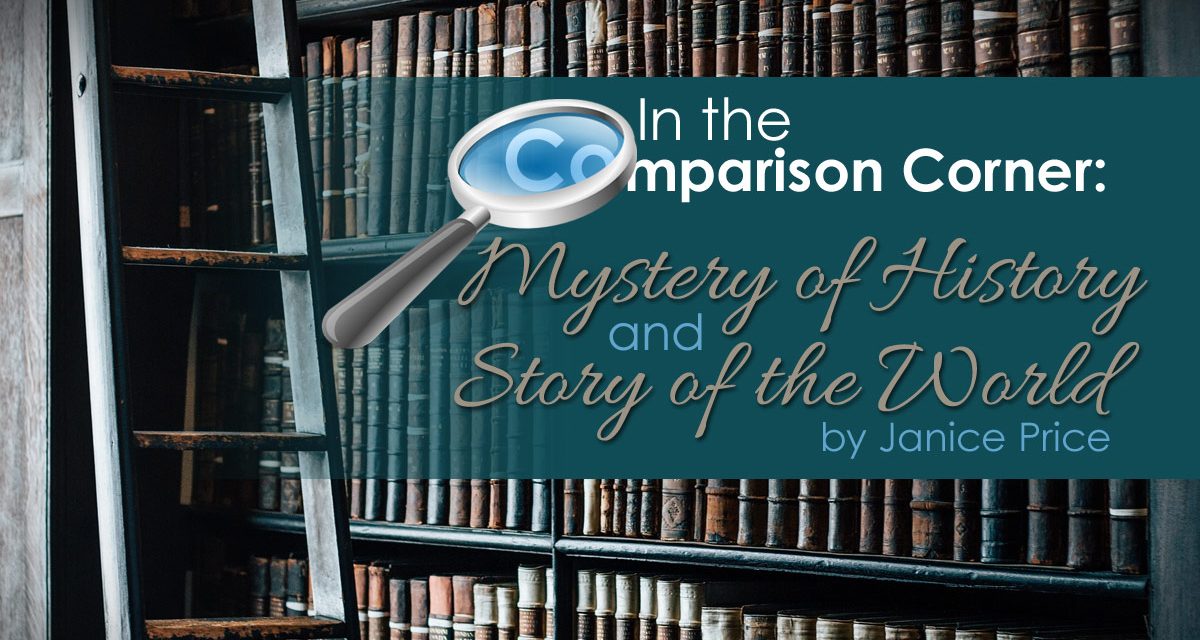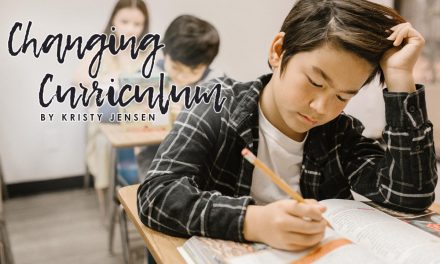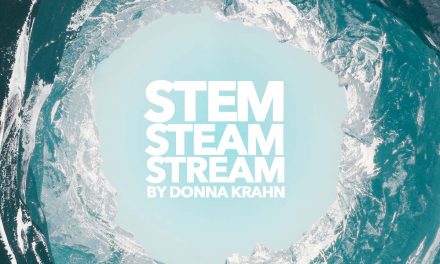We offer these comparisons with the goal of helping our customers find the perfect F-A-M-I-L-Y fit. [Faith/Philosophy; Approach; Money; Individual; Life; and You – see the Choosing Curriculum workshop for additional information.] Rather than a recommendation for any particular program, they provide a look at similarities and differences. Order of mention is not indicative of preference.
In the realm of social studies, there are varying opinions (what a surprise!). Some educators are convinced young children should learn first about the world around them (community workers) and expand from there. Others prefer to start with American history. And others, usually with either a classical or Charlotte Mason bent, maintain that “social studies” is more accurately “history” and should be studied chronologically, in tandem with geography, starting with the ancient civilizations. Two such programs with this last perspective, Story of the World (SOTW) and Mystery of History (MOH), both well-known, with enthusiastic followers, are often compared and sometimes confused.
You may find yourself in two Greek cities celebrating peace by running races on Mount Olympus (and establishing the Olympics, by the way) or with Henry VIII and his bewildering succession of wives. Both Mystery of History and Story of the World pull the reader/listener into far-away places and long-ago times with a story presentation of historical events. Both programs offer texts, which are essentially readers, covering four time periods; each spanning an entire year. The exact dates for these periods vary between the series but, generally, are ancient, middle ages, renaissance/exploration, and modern. With an emphasis on timeline activities and mapping activities, the student is encouraged to develop a big picture of world happenings.
There is one major difference between these two programs. Although world-wide in its orientation, Mystery of History is decidedly Christian: in fact, calling itself “His” story in reference to divine interactions in the human world in the form of Jesus the Christ. Story of the World, on the other hand, takes a “neutral” approach. Starting with the first recorded civilizations (rather than references to “cave-men” or “pre-history”), biblical/Christian history is covered alongside the development of other religions and cultures.
There are similarities and subtle differences in the target age/grade of the two series. While both can be used with multiple ages simultaneously, SOTW’s beginning volumes target a younger audience (early elementary; written at about a 4th grade reading level), while its later volumes (Vol 3 and 4) have a higher reading level. For MOH, middle school is the target audience. Vol 1 starts with 4th/5th grade reading level which increases through the series. SOTW stays close to a five year grade range on their books [i.e. Vol 1 (1-5); Vol 2 (2-6); Vol 3 (3-7); and Vol 4 (4-8)] while MOH offers options for using their material with both younger (early elementary) and older (high school) students. The author of SOTW, Susan Wise Bauer, is in the process of writing a sequel series of texts and study guides for an older audience (grades 6-12) – History of the (Ancient, Medieval, Renaissance) World.
MOH readers vary in format currently but are moving towards a standard-sized hardcover format with both full-color photos, artwork and maps. The SOTW readers, in contrast, although available in either hard or soft cover versions, are smaller, with relatively sparse black and white illustrations and maps. Audiobooks in CD form are available for all of the SOTW volumes and for volumes 1-3 of MOH (Vol 4 audiobook is a download). Perhaps due to the minimal illustrations in the reader, SOTW encourages the use of a history encyclopedia (Kingfisher History Encyclopedia or Usborne Book of World History). MOH includes reading suggestions for various ages.
Course components for Story of the World are consistent through the volumes: hardcover and softcover versions of the Text/Reader; Audiobook CDs, Activity Book, Student Pages (one set of the student pages from the Activity Book), and Tests/Answer Key. The Activity Book is partly a teacher guide with suggestions for supplemental reading and resources as well as fun activities (such as mummifying a chicken) and partly reproducible Student Activity Pages which tend to be map and timeline oriented. The Tests are optional and primarily used when grades need to be reported.
Mystery of History has more variation among program components. In each, the Text/Reader is the heart of the course. Volumes 1, 3 and 4 are just the reader with a separate Companion Guide PDF available as either a download or on the included CD-ROM. Volume 2 has reproducible student pages as part of the Text which are also available as printable PDFs in the Companion Guide CD. Material included in the Companion Guides include weekly pre-tests and quizzes, exercises, worksheets, activity instructions, tests, outline maps, resource lists, answers (where applicable) and appendix pages. MOH suggests the use of Homeschool in the Woods timelines.
Choosing between these two programs can be tricky. SOTW has a more classical bent and is perhaps a bit more pick-up-and-go friendly, especially for the early elementary grades. On the other hand, MOH provides more age/grade diversity with readers that are more visually appealing. For many, the choice will be based on the obvious Christian content found in MOH. There is one more difference between the two that is difficult to describe. I would call it “flavor.” SOTW has a sweeping sense of culture development in the various geographical areas of the world. MOH is more event-focused, describing world happenings and personages in sequence. The bottom line, however, is that families using either program can expect to become very knowledgeable about world history and to do so in a delightful manner.
Like Mystery of History and Story of the World, there are other programs that cover world history over the course of several years. These also provide history in story form, are adaptable for various learning styles, and allow for the possibility of multiple ages although a program may have a particular target audience. Each has its own distinct strengths. Some might have particular characteristics that would make them a better fit for your family. The Rainbow consultants are always available and eager to help you make the best curriculum choice for your students and family. You can contact us during our office hours (M-F, 8:30 am to 5:00 pm Central) by phone (888-841-3456) and LiveChat from our website, or email (consultants@rainbowresource.com).





